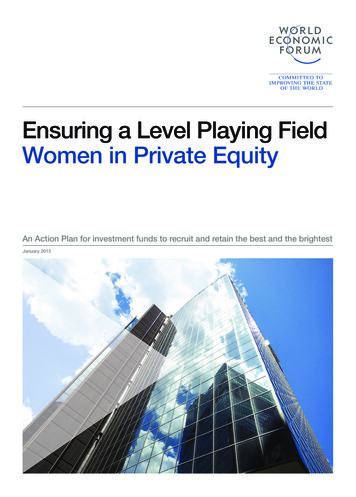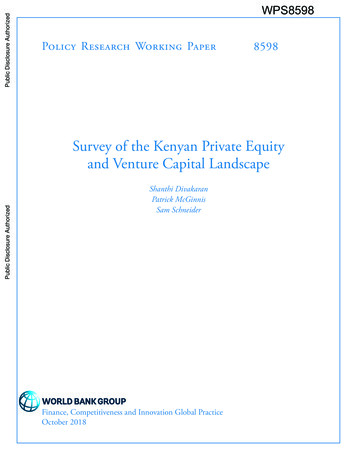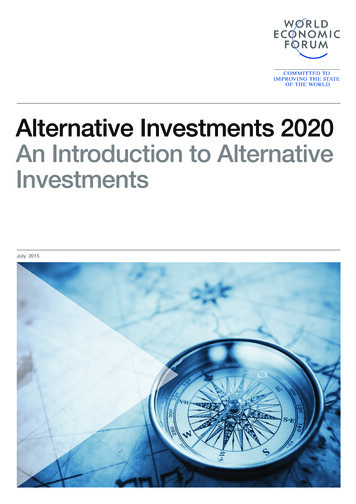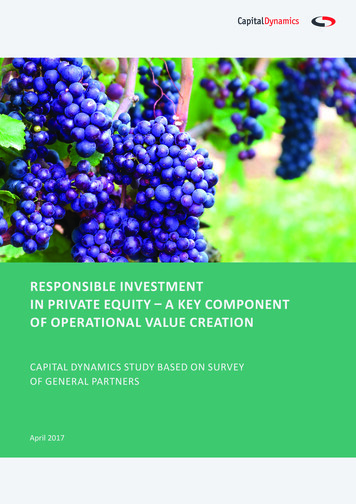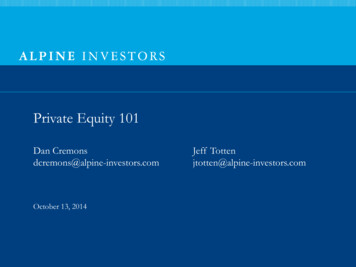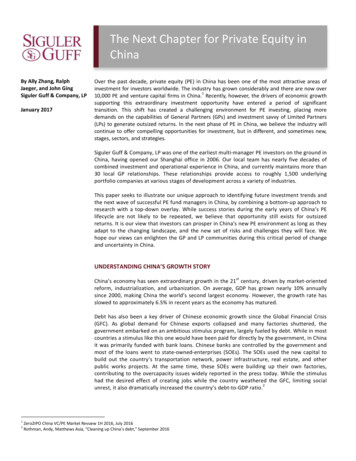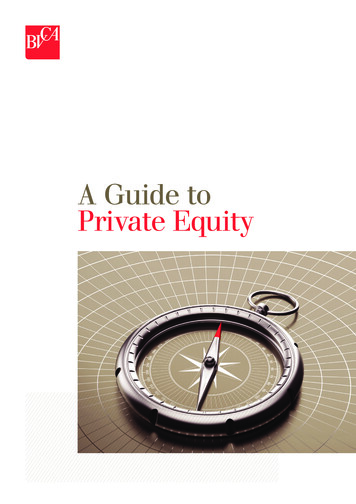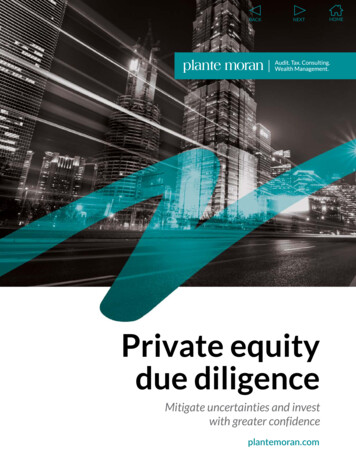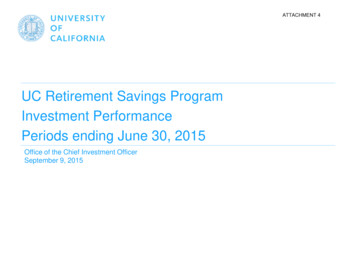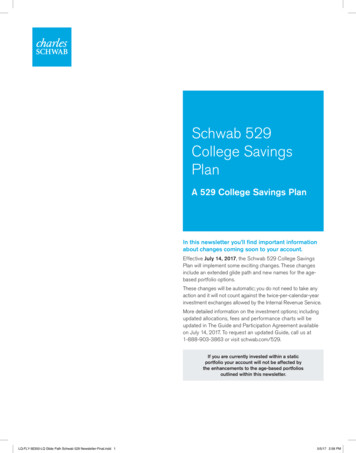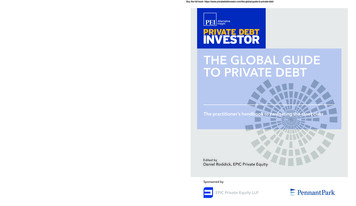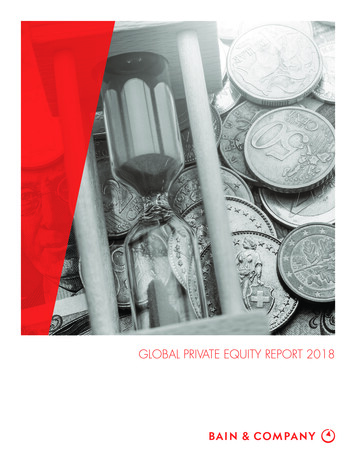
Transcription
GLOBAL PRIVATE EQUITY REPORT 2018
About Bain & Company’s Private Equity businessBain & Company is the leading consulting partner to the private equity (PE) industry and its stakeholders. PEconsulting at Bain has grown sevenfold over the past 15 years and now represents about one-quarter of thefirm’s global business. We maintain a global network of more than 1,000 experienced professionals servingPE clients. Our practice is more than triple the size of the next largest consulting company serving PE firms.Bain’s work with PE firms spans fund types, including buyout, infrastructure, real estate and debt. We also workwith hedge funds, as well as many of the most prominent institutional investors, including sovereign wealthfunds, pension funds, endowments and family investment offices. We support our clients across a broad rangeof objectives:Deal generation. We help develop differentiated investment theses and enhance deal flow by profiling industries,screening companies and devising a plan to approach targets.Due diligence. We help support better deal decisions by performing commercial due diligence, using operationaldue diligence to assess performance improvement opportunities, and providing a post-acquisition agenda.Immediate post-acquisition. We support the pursuit of rapid returns by developing a strategic value-creationplan for the acquired company, leading workshops that align management with strategic priorities and directingfocused initiatives.Ongoing value addition. We help increase company value by supporting revenue enhancement and cost reductionand by refreshing strategy.Exit. We help ensure that funds maximize returns by identifying the optimal exit strategy, preparing the sellingdocuments and prequalifying buyers.Firm strategy and operations. We help PE firms develop distinctive ways to achieve continued excellence by devisingdifferentiated strategies, maximizing investment capabilities, developing sector specialization and intelligence,enhancing fund-raising, improving organizational design and decision making, and enlisting top talent.Institutional investor strategy. We help institutional investors develop best-in-class investment programs acrossasset classes, including private equity, infrastructure and real estate. Topics we address cover asset class allocation,portfolio construction and manager selection, governance and risk management, and organizational design anddecision making. We also help institutional investors expand their participation in private equity, includingthrough coinvestment and direct investing opportunities.Bain & Company, Inc.131 Dartmouth StreetBoston, Massachusetts 02116 USATel: 1 617 572 2000www.bain.com
Global Private Equity Report 2018 Bain & Company, Inc.ContentsResponding to the challenge. . . . . . . . . . . . . . . . . . . . . . . . . . . . . . . . . .1.pg. iiiThe private equity market in 2017: What happened?. . . . . . . . . . . . . . . . . . pg. 1Investments: Searching for value in a crowded market. . . . . . . . . . . . . . . . . pg. 1Exits: More discipline, more value. . . . . . . . . . . . . . . . . . . . . . . . . . . . . . . pg. 9Fund-raising: The good times roll on. . . . . . . . . . . . . . . . . . . . . . . . . . . . . pg. 14Spotlight on long-hold funds: Opening up new horizons. . . . . . . . . . . . . . . pg. 21Returns: Strong momentum, but for how long?. . . . . . . . . . . . . . . . . . . . . . pg. 24Key takeaways. . . . . . . . . . . . . . . . . . . . . . . . . . . . . . . . . . . . . . . . . . . pg. 30Spotlight on retail healthcare: An island of growth. . . . . . . . . . . . . . . . . . . pg. 312.Creating value from the inside out. . . . . . . . . . . . . . . . . . . . . . . . . . . . . . pg. 37Fit-for-purpose talent: Matching leaders tomission-critical roles . . . . . . . . . . . . . . . . . . . . . . . . . . . . . . . . . . . . . pg. 37Commercial excellence: Accelerating organicrevenue growth. . . . . . . . . . . . . . . . . . . . . . . . . . . . . . . . . . . . . . . . . pg. 45Digital savvy: Seizing opportunity amid rapid change. . . . . . . . . . . . . . . . pg. 51Spotlight on Amazon: Coping with the Amazonfactor in due diligence. . . . . . . . . . . . . . . . . . . . . . . . . . . . . . . . . . . . pg. 623.Beating corporate buyers at their own game . . . . . . . . . . . . . . . . . . . . . . . pg. 67Page i
Global Private Equity Report 2018 Bain & Company, Inc.Page ii
Global Private Equity Report 2018 Bain & Company, Inc.Responding to the challengeDear Colleague:Overall, 2017 delivered very good news for the private equity industry. It was a year of increasing investment,strong exit markets, attractive returns and hot fund-raising activity. All of this good news has attracted somuch attention (and capital), however, that the industry’s structural challenges have sharpened. If it’s possible,fund-raising has been too good, with an unprecedented 3 trillion raised over the past five years. Investmentdollars are indeed up, but deal count has dropped substantially since 2014. Multiples are at all-time highs,with around half of all companies acquired priced in excess of 11 times earnings before interest, taxes, depreciation and amortization. In such a frothy environment, how can funds generate the attractive returns theirlimited partners expect?First, we need to remember that “the end of private equity as we know it” has been proclaimed before. Over thepast decade, we’ve confronted the specter of large-scale insolvency in portfolios, debt refinancing cliffs thatseemed impossible to scale, lower returns that bit into LP confidence, and exit issues amid market volatility andbuyer-seller valuation gaps. Each time, the PE industry has responded by continuing to evolve and continuing todeliver for its constituents. Private equity is nothing if not a resilient business.So, how is the industry responding to the current situation? As ever, funds are turning to a mix of tactics andstrategies. On the tactical side, we see general partners aggressively assessing and measuring portfolio management talent, an area where the margins for error are thin and getting thinner. They are also exploring how thepace of technological change is altering industry profit pools, with an eye toward taking advantage of new opportunities before others see them and avoiding pitfalls prior to investment. The GP mindset around assessing risksand opportunities over a typical holding period hasn’t changed. Yet funds do require new tools and lenses tounderstand how technology affects industries, as evidenced by the rapid ascent of Amazon and its impact onretailers, consumer products companies, distributors, equipment manufacturers and many other businesses.The good news is that these changes and shifts can all be analyzed and understood.PE firms are also continuing to hone their activist approaches to creating value in partnership with management.Gone are the days of investing passively and simply trusting management to get the job done. That’s an unfairexpectation, really. Given current asset prices, rapidly changing industries and markets, and the need in manycases to transform the value of assets acquired, few management teams are prepared from day one to take on allthe challenges. One example of this spirit of partnership in the business-to-business space is the emergence ofaggressive commercial excellence programs to stimulate organic growth, which has been elusive in many industries since the Great Recession. Funds are applying many other approaches to working with management onboth the revenue and cost sides.Strategically, there are plenty of deals out there to be done that could absorb the record amount of dry powderraised by GPs. During 2017, more than 38,000 companies were bought and sold globally, but private equityaccounted for less than 10% of those deals. Increasing the industry’s share of the M&A market by winning morelarge-scale deals is an obvious way to invest the mountain of cash raised. The question is, how? PE firms need toearn greater equity returns than the corporate buyers they compete against, and the deal peak of 2006–07 offeredPage iii
Global Private Equity Report 2018 Bain & Company, Inc.many cautionary tales about the cost of overreaching. For larger firms, the answer may lie in becoming more likea “corporate,” albeit one that is more efficient and aggressive in all respects. That means using scope and scaledeals to add large assets to equally large platforms, capturing synergies and playing the same game as manycorporations, only with a higher bar.We hope you will enjoy the discussion of many of these topics in Bain’s latest Global Private Equity Report. Bestwishes for a prosperous 2018!Hugh MacArthurHead of Global Private EquityPage iv
Global Private Equity Report 2018 Bain & Company, Inc.1. The private equity market in 2017: What happened?The global private equity (PE) industry posted another solid year in 2017, as buyout value and exits both showedhealthy gains. Firms closed out the strongest five-year stretch for fund-raising in the industry’s history as limitedpartners (LPs) continued to respond to PE’s outperformance vs. other asset classes by flooding the market withnew capital. Growing investor enthusiasm produced the largest buyout funds ever raised in the US, Europe andAsia, and served as a ringing endorsement of the industry’s prospects in the years ahead. But it also intensifiedthe pressure on general partners (GPs) to keep the good times rolling.That won’t be easy. While GPs worked hard to put all their new capital to work, they continued to run into roadblocks that limited the number of deals closed during the year. Heavy competition for assets and record-high dealmultiples made it increasingly difficult to find new targets and close new transactions at attractive prices, a trendthat has put downward pressure on deal numbers for the past several years. As we’ll explore in greater depth inSections 2 and 3, the challenge in the years ahead will be to find new ways to generate growth and underwritevalue. In 2017, however, the industry had plenty to celebrate. Investments: Searching for value in a crowded marketDespite the increasingly difficult environment for finding and winning deals, PE funds globally produced welcomegrowth in investment value in 2017, even if the number of individual deals continued to disappoint (see Figure 1.1).Figure 1.1Global buyout investment value and deal count, including add-ons,tracked higher in 2017Global buyout deal value (includes add-on deals)Deal count5,000 4 78131 119811501172402172872544403692,000301Total countRest of pe14%North America10%1996 97 98 99 00 01 02 03 04 05 06 07 08 09 10 11 12 13 14 15 16 17Add-on countpercentage9 17 25 25 27 33 29 27 28 29 29 33 36 36 37 41 40 41 45 49 48 50Add-on valuepercentage 14 16 16 15 18 168 11 12 179 10 13 24 12 26 20 15 31 43 22 24Notes: Excludes loan-to-own transactions and acquisitions of bankrupt assets; based on announcement date; includes announced deals that are completed or pending, with datasubject to change; geography based on target’s locationSource: DealogicPage 1
Global Private Equity Report 2018 Bain & Company, Inc.Including add-on transactions, global buyout value grew 19%, to 440 billion, supported by a stream of large publicto-private deals. On the other hand, global deal count was essentially flat, growing just 2%, to 3,077 deals. That’s off19% from 2014, the high-water mark for deal activity in the current economic cycle.This disconnect between the value and number of deals reflects a stubborn dynamic affecting deal making in mostregions around the world: While funds have ample money to spend, they have too few attractive targets on whichto spend it. Investors have allocated more capital to private equity over the past five years than at any time in history,prompting some observers to wonder whether the market is in danger of overheating. In the search for ways to putmoney to work, however, GPs are hampered by several factors—high valuation multiples, stiff competition and anuncertain macroeconomic outlook that complicates future value calculations. These factors are forcing funds to beselective, and in some cases prompting them to stay on the sidelines. Yet as dry powder, or uncalled capital, continuesto accumulate, the pressure to do deals is only building, testing the industry’s ability to maintain discipline.Regular readers of Bain’s Global Private Equity Report may notice that we’ve included add-on deals in our investmenttotals for the first time. These transactions, used to acquire assets that are then added on to existing platform companies, are typically excluded from industry value and deal count calculations. Over the last several years, however,they have become an increasingly important part of PE activity. At a time when high prices make it challenging toacquire new platform companies, GPs are gravitating to add-ons for several reasons. Funds can use them to executebuy-and-build strategies that turn a collection of smaller companies acquired at lesser multiples into a large enterprise with a premium valuation. They allow funds to take advantage of synergies to underwrite higher asset prices,and can give a trusted leadership team a bigger set of assets to manage. While add-ons made up around a third ofall deals a decade ago, they comprise half the total today. Because add-ons tend to be smaller than platform deals,however, they represent only about 25% of total deal value. Their smaller size, combined with the fact that they arenot always purchased with PE fund dollars, means add-ons soak up far less excess capital than platform buyouts.The expanding size of platform deals, in fact, was the largest factor behind 2017’s healthy jump in global investment value. The size of the average disclosed buyout, excluding add-ons, has been climbing for six years and hita record high of 675 million in 2017. These large deals punched up value totals in all regions. In North America, deal value, including add-ons, rose to 196 billion, mostly on the strength of a number oflarge carve-outs and public-to-private deals, including Sycamore Partners’ 6.8 billion acquisition of Staples. In Europe, several large deals, including the 6.4 billion leveraged buyout of Danish payments firm Nets, ledby Hellman & Friedman, boosted value to 147 billion on a 2% increase in deal count. Deal value in the UK rose 7%, to 39 billion, despite ongoing uncertainty about how Brexit will affect thenation’s currency and economic outlook. As disruptive as Britain’s exit from the European Union has been,investors appear confident that London’s dominant role in the financial markets augurs well for the UK’scontinued place in the global economy. Asia-Pacific was a true bright spot for deal making in 2017. Buyout value surged 74% in the region, to 83 billion,propelled by the year’s largest buyout globally—the 17.9 billion carve-out of Toshiba Memory Corp. led byBain Capital, among others. China and India also produced their share of big deals as a number of largebuyout firms turned their sights on the region. Slowing economic growth cooled valuation expectations, raising the number of attractive targets.Page 2
Global Private Equity Report 2018 Bain & Company, Inc.A flood of buyout capitalIn many respects, these should be the best of times for GPs, as both equity and debt capital are rushing into themarket on a flood tide. On the equity side, five years of record-level fund-raising have left the industry flush withcapital to spend. Dry powder has been on the rise since 2012 and hit a record high of 1.7 trillion in December 2017(see Figure 1.2).The debt markets, meanwhile, are red hot, offering GPs a golden opportunity to fund transactions with heftylevels of low-cost leverage. The markets for speculative bonds and leveraged loans are as robust as they’ve everbeen, as investors clamor for higher yields to augment their returns in a sustained low-interest-rate environment. Although there were exceptions to the general enthusiasm—debt investors balked at an attempt to takeNordstrom private, for example—the strong demand for high-yield paper heavily favored deal makers in 2017.The average debt multiple stretched toward six times earnings before interest, taxes, depreciation and amortization (EBITDA), the level at which regulators begin to pay close attention (see Figure 1.3). And a number ofhigh-profile deals piled on even more leverage. The 4.3 billion buyout of USI Insurance Services led by KKR,for instance, pushed the company’s leverage ratio just above eight times EBITDA, according to Moody’s. Thatkind of leverage is coming on increasingly easy terms. The number of so-called covenant-lite loans—those withfew benchmarks or restrictions for borrowers—has been growing rapidly since 2012 and totaled roughly threequarters of overall loan volume in both the US and Europe at the end of 2017.Figure 1.2Dry powder, especially uncalled buyout capital, continues to pile upglobally, setting a new record in 2017Global PE dry powder .01.01.21.00.80.50.60.4–4%Direct lending36%Distressed PE–5%Growth33%Infrastructure0.4Venture capitalReal 433449475516633As of year-endBuyout( B)185176256375435477478424390Note: Discrepancies in bar heights displaying the same value are due to roundingSource: PreqinPage 3–14%Mezzanine6%12%3%23%
Global Private Equity Report 2018 Bain & Company, Inc.Figure 1.3Ample supplies of inexpensive debt have led to higher leverageAverage debt/EBITDA multiple for large US LBO 0304First-lien debt/EBITDA0506070809Second-lien debt/EBITDA101112Other senior debt/EBITDA13141516Q3 17Subordinated debt/EBITDANote: Large LBO transactions defined as issuers with EBITDA greater than 50 millionSource: S&P Capital IQ LCDSoaring valuationsIf easy money provided an accelerant for deals in 2017, soaring asset prices and fierce competition pumped thebrakes on market activity. Average purchase price multiples for leveraged buyouts (LBOs) rose to historic highs,hindering GPs’ efforts to put dry powder to work (see Figure 1.4).Although lenders and bondholders are willing to fund deals with maximum debt levels, there’s a point at whichdeal makers run into diminishing returns. As noted, deals that incorporate six turns of leverage begin to attractheightened regulatory scrutiny, meaning the upper limit of borrowing is not far above that. When deal multiplesclimb, GPs have to make up the difference with more equity. The capital is clearly available, but a higher ratio ofequity to debt decreases the deal’s internal rate of return (IRR), making it more difficult to justify.That is especially true at a time when the macro outlook in the US and Europe raises real questions about howlong the global economic expansion can continue. “Every one of our base cases now involves a recession,” ToddAbbrecht of Thomas H. Lee Partners recently told an industry conference. Investors are unlikely to face a downturn in 2018, according to Bain’s Macro Trends Group, but our economists agree with most others that the USeconomy is highly likely to experience a recession over the next five years. And though Europe’s recovery hasunfolded more slowly (meaning it may have longer to run), a recession in the US could easily trigger a downturnon the continent and in the UK.The cloudy outlook renders it frustratingly difficult for GPs to make assumptions as they put together deal models.Given sustained competition, valuation multiples may not retreat much in the face of slowing economic growth.Page 4
Global Private Equity Report 2018 Bain & Company, Inc.Figure 1.4Buyout purchase price multiples rose to a new high in 2017Average EBITDA purchase price multiple for US LBO 0.09.816Q1 1711.27.78642020080910Senior debt/EBITDA14Subordinated debt/EBITDA15Equity/EBITDAQ2 17Q3 17OtherSource: S&P Capital IQ LCDStill, it’s hard to expect that further multiple expansion will push a company purchased at 12 times EBITDA todayto 15 times a few years from now. Speaking at the same conference as Abbrecht, Alan Jones, coleader of MorganStanley Global Private Equity, put it this way: “Our presumption is that we’ll be exiting at smaller multiples. Ifwe’re wrong, it means we planned for a future that was worse than what actually happened.”Stiff competitionOne thing GPs can count on is that competition for assets isn’t likely to abate in coming years. If anything, it may worsen.The number of PE firms hunting deals has risen steadily each year for decades and now totals 7,775 (see Figure 1.5).Corporate buyers, meanwhile, continue to scour the world for growth through acquisition, routinely showing upat auctions that involve attractive targets of all sizes. That’s a problem for PE buyers because corporations haveseveral built-in advantages that improve their odds in competitive bidding, including a lower cost of capital andwillingness to pay up for synergies or strategic value. Because GPs often lose out in head-to-head competitionwith corporate buyers (looking at standalone, or platform, assets only), private equity’s share of overall M&Aactivity globally declined in 2017 for the fourth year running.The horde of corporate buyers isn’t likely to disappear anytime soon. Flat or slowing economic expansion aroundthe world makes it hard for many companies to achieve organic growth and reach strategic objectives, whichmeans public investors are quick to reward those that generate growth through acquisition. According to Bainresearch, companies that made 12 or more acquisitions between 2005 and 2015 enjoyed 39% higher shareholderreturns than those that made no acquisitions over the same period.Page 5
Global Private Equity Report 2018 Bain & Company, Inc.Figure 1.5The number of PE firms globally continued to climbAll PE firmsBuyout firmsNumber of active PE firmsNumber of active buyout firms10,0001,5008,0001,0006,0004,0005002,00001990 92 94 96 98 00 02 04 06 08 10 12 14 1691 93 95 97 99 01 03 05 07 09 11 13 15 1701990 92 94 96 98 00 02 04 06 08 10 12 14 1691 93 95 97 99 01 03 05 07 09 11 13 15 17Buyout (existing)Buyout (new)North AmericaEuropeOther PE (existing)Other PE (new)Asia-PacificRest of worldNotes: Excludes PE firms that do not manage and invest out of distinct funds; a PE firm is considered active for 10 years after raising its last fund; new PE firms based on thevintage of firm’s first fund; geography based on location of firm’s headquartersSource: PreqinHistorically, corporate buyers have tended to ignore acquisition targets that don’t add scale. But that’s changing ascompany leaders see ways to use acquisitions to serve other objectives, like augmenting product development,acquiring talent and accelerating distribution. Consumer companies struggling to develop new brands, for instance, are increasingly looking for candidates on the outside and plugging them into their portfolios. Think ofConagra’s acquisitions of Thanasi Foods (maker of Duke’s meat snacks) and Angie’s Artisan Treats, or Nestlé’sbuyout of Blue Bottle Coffee. Corporate interest in the middle market is especially nettlesome for PE firms thatspecialize in buying smaller companies, building them to scale and then selling them at a profit to exactly thekinds of large companies they are now trying to outbid at auction.In the past few years, more large companies have borrowed a page from the technology playbook, setting upcorporate venture capital (VC) units tasked with investing in companies that might be additive strategically. Techplayers like Google, Intel and Dell still account for most corporate VC activity, but companies like Unilever andKellogg are getting in the game. Overall, the value of corporate VC deals globally has risen dramatically overthe past several years, to 51 billion in 2017, and the average deal size has expanded steadily (see Figure 1.6). Thenumber of corporate VC investors remains relatively small, but it has doubled to 262 in the past four years.For GPs, these trends have made for fierce competition from well-heeled corporate buyers for targets of all sizes.That competition is boosting multiples in the middle part of the market, such that buyers are paying almost asmuch per dollar of EBITDA for midsize companies as they are for large ones.The subdued deal activity numbers suggest that, presented with inflated asset prices and easy money, GPs are sofar showing discipline. The market has gotten frothy enough that many GPs are wary of doing what may turnPage 6
Global Private Equity Report 2018 Bain & Company, Inc.Figure 1.6Corporate venture capital deals are a growing source of competitionin the middle marketDeal countGlobal corporate venture capital deal value2,000 otal count10North America13Asia-Pacific1415Europe1617Rest of worldNotes: Includes deals that involve at least one corporate venture capital investor; includes announced and completed deals at all stages of funding; geography based on target’s location;discrepancies in bar heights displaying the same value are due to roundingSource: PitchBookout to be a weak deal under pressure. The problem is that waiting on the sidelines poses its own form of risk.GPs that hesitate to put money to work this year may find that conditions are even more difficult in the future.Searching for pockets of opportunityHow are GPs adjusting to this new normal of steep valuations and unrelenting competition? Firms are gettingproactive in pursuing a number of strategies: Looking over the hedge. With the number of sponsor-to-sponsor deals on the rise, more PE firms are combing through the portfolios of other funds, looking for promising companies that might be coming up forsale. The practice has been especially popular in Europe, but it also gained steam in North America in 2017.The analysis is fairly straightforward: Given the five-year investment time frame most buyout firms adhereto, GPs scour active portfolios for companies with specific characteristics that have been held for at leastthree years. Isolating a short list of promising candidates allows firms to get a jump on due diligence. Theobjective is to be smarter and better prepared than other bidders when the asset comes up for auction. Walking among the zombies. One truth about PE funds is that they are notoriously hard to kill. Zombiefunds are essentially the walking dead; they have stopped raising new capital but are still working throughportfolios. Our definition of a zombie fund is a buyout fund that raised its initial capital between 2003 and2008 but has not raised capital since and hasn’t executed a buyout deal since 2015. We’ve identified 19 ofthese funds in North America and Europe, and their holdings of more than 100 companies are plausiblecandidates for ownership change in 2018.Page 7
Global Private Equity Report 2018 Bain & Company, Inc. Picking up the pieces. Corporate carve-outs accounted for around one in five deals in the US and Europe overthe past few years. They should continue to provide steady deal flow for buyout funds thanks to the persistentcatalysts feeding the trend—activist shareholders calling for disposal of noncore assets, companies’ owndecisions to rationalize, conglomerates looking to get smaller and more focused. Taking on a challenging asset. GPs will likely need to sharpen their pencils to underwrite more challenging strategies, like chasing higher growth or tackling a tricky turnaround. Often, that entails building stronger capabilities tomanage risk. KKR’s carve-out of Unilever’s spreads business, for instance, will present a challenge given decliningconsumption of margarine. But the firm will work to turn around years of underperformance and position thebusiness for long-term growth. TPG Capital and Welsh, Carson, Anderson & Stowe also took on a complex dealwhen they announced that they would team up with Humana to take Kindred Healthcare private for 4.1 billion.Under the deal’s unique structure, the funds and Humana will take on Kindred’s home care business, while carvingout the company’s specialty hospital assets as a standalone company. Although the long-term acute care part of thebusiness has been challenged in recent years, the opportunities outweigh the risks for TPG and Welsh, Carson. Ramping up public-to-private activity. As we predicted last year, public-to-private conversions are on the upswing.As price-to-EBITDA multiples paid in the private markets converge with valuations in the public markets, morepublic companies become potential take-private targets. Public companies tend to be bigger companies, andtaking them private presents an opportunity for funds to put a lot of capital to work. They are also attractive tolenders, which are eager to finance these mega-transactions. The number of public-to-private conversions in2017 increased from 2016, and the average deal size jumped substantially. Consequently, the total value ofthese buyouts surged to 180 billion in 2017, nearly twice the level of the year before (see Figure 1.7).Figure 1.7The value of PE-led public-to-private conversions nearly doubled in 2017as the deals became increasingly largerGlobal public-to-private deal valueDeal count200 500B423400404150300100200180126891004674271
Due diligence. We help support better deal decisions by performing commercial due diligence, using operational due diligence to assess performance improvement opportunities, and providing a post-acquisition agenda. Immediate post-acquisition. We support the pursuit
